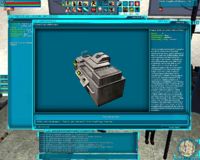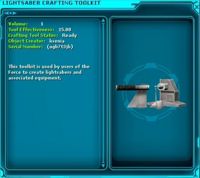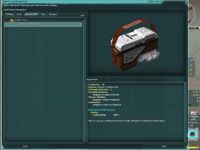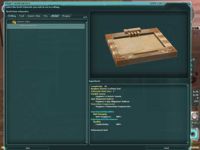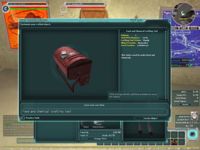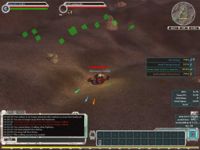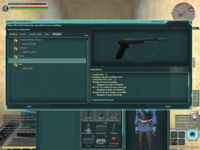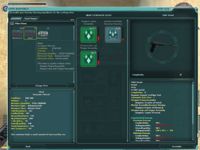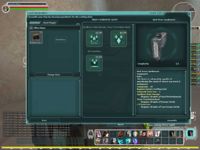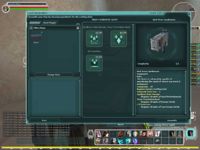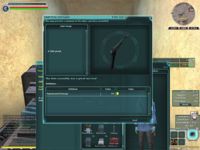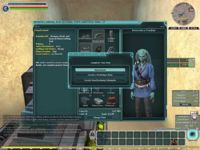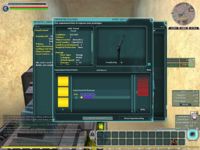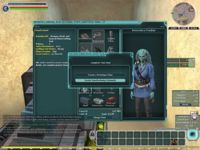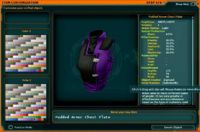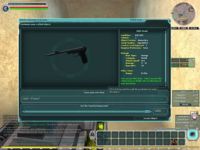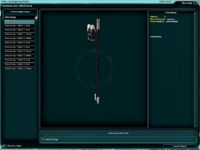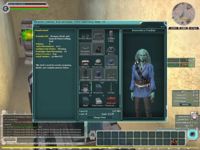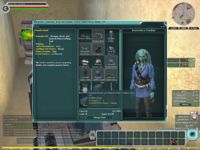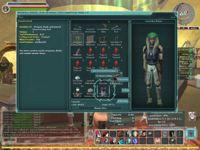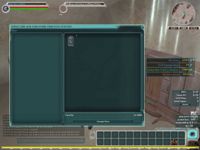Difference between revisions of "Crafting Tool (Game Mechanics)"
(→Crafting Stage 6) |
(→System Messages) |
||
| Line 68: | Line 68: | ||
== System Messages == | == System Messages == | ||
| − | * [[Crafting | + | * [[General Crafting Messages (Game Messages)|Crafting tool Production]] |
| − | * [[ | + | * [[Experimentation Messages (Game Messages)|Experimentation]] |
| − | + | ||
== Radial Menus == | == Radial Menus == | ||
Revision as of 05:35, 24 August 2009
| This article or section needs proper wiki formatting. |
Game Mechanics - Mechanics Category
SWGANH Wiki is a repository of Star Wars Galaxies Developer information. This site is only meant to be used by SWGANH Developer team.
|
|
System MessagesRadial MenusTypes of tools
There are three types of crafting tools, Generic Crafting Tools and Specialized Crafting tools and Lightsaber crafting tools. The Generic Crafting Tool is the most basic crafting tool you will use. It's the key to making the items you want to make. All beginning crafters start with this tool. Specialized crafting tools consist of five different types with these being the Food and Chemical, Clothing and Armor, Structure and Furniture, Weapon Droid, and General Item, and the Starship Crafting tools. These must be constructed by a crafter using a generic tool or a weapon, droid and general item tool. The chief differences between these tools is that item experimentation is not allowed on items created using a generic tool where as it is allowed while using a specialized tool.
An important thing to note about Crafting tools is that they cease operating if their condition gets to 0.
Creatures (Food & Chemical Tool)
Special Note 2: These tool/tab pair ups only show the general types of items found under these. All tier items are usable by specialized tools and all items of complexity 1-15 within each given category where a generic crafting tool is listed are usable by the generic tool. So for example, a Food and Chemical tool used by a chef at a private station will list all items under Food section, including schematics 1-15 complexity. A generic tool will also list all foods under the Food tab that range from 1-15 complexity since it can handle all items of 1-15 complexity. There are exceptions to this rule, which are light saber components. These only display within a light saber crafting tool under the Lightsaber tab.
Tool Effectiveness This is an attribute of the crafting tool itself. Its function is to server as a modifier to the random roll event for experimentation and assembly. Having a positive value in this will mean a bonus to the roll, where having a negative will decrease chances of favorable rolls. Generic Tools given to new players all have a 0.0 effectiveness rating.
Item Complexity
Item complexity is a value given to every schematic of which affects the length of time for craft tool and factory production as well as determining which schematics the player can use or not with any given tool. When an item goes through the full crafting process and is completed, the crafting tool will take an amount of time equivilant to 2 x complexity of schematic as the total number of seconds that will pass before the item is created as a prototype from the crafting tool. For factories this timer is 8 x complexity of schematic and determines the total time that it will take in seconds for each item to be produced and deposited into the factory output hopper. Item complexity's effect on the selection of available schematics comes in the following manner. These schematics only show up to the player in the crafting tool if they meet the appropriate qualifications. Item schematics are broken down into 3 categories. The first category are those schematics that can be used with a generic crafting tool. These incorporate all schematics that range from complexity 1 to 15. The second category are those schematics that can be used with only a specialized tool. These schematics range from complexity 16-20. The third grouping of schematics are those that require a specialized tool and at least a public crafting station (those found in npc cities or ranger camps). These schematics range from 21 to 25. The fourth and last grouping of schematics are those that require a specialized tool and a private (player crafted) crafting station. For clarification, all lower tiered schematics can be used by the next highest tier. This means that schematics from 1-20 can be used with just a specialized tool, 1-25 complexity can be used at a public station with a specailized tool, and a private station with a specialized tool can use all schematics.
When a character wishes to begin crafting and has the proper schematics and resources available, they may begin the crafting tool process which is broken into 6 unique stages.
Crafting Stage 1Stage 1 begins with a list of usable/viewable schematics. After selecting the appropriate schematic,the player clicks on on next to continue to the next stage or exit to abort the crafting process all together.
Crafting Stage 2This window has two important sections. The first is a view of your inventory, filtered to show only the resources that can be used to make the item you have chosen. If a resource does not show up in this panel then it's off no use to you at the moment. The main panel in the center shows you the components that you must make with resources in your inventory.
The Assembly screen allows you to place components into your schematic. When you open a schematic, your available resources and components will appear in a window on the left side of the screen. Each schematic has "slots" for specific components. When you click on an available component or resource, any slots that can hold that type of component will glow green. Remember, you are unable to mix and match resources in these components. If a component slot requires 100 Steel then you can fill it with part of a 500 stack of Dirobeda Steel, or two 50 unit stacks of Ixone Steel or a 100 stack of Doldit Steel. You can not fill it with 50 Dirobeda and 50 Ixone. The amount entered has to be entirely of one type or another. On the left side of the window there is an option to filter contents within the inventory. This toggles whether or not the player wishes to see all items within their inventory on that list or if they wish to only see items that are usable in the schematic. The filter also works with containers in the inventory. If a player has a container within their inventory that has usuable resources then it will be displayed in this window as well. The player may also browse inside of it by double clicking the item. To get back to the top level inventory the player must click the small button in the upper right of the left hand window.
Click and drag components into the appropriate schematic slots or double-click on the components to allow the crafting device to automatically assign them to an appropriate slot. Like characters, each resource and component has its own set of attributes that directly affect the quality of the object you're crafting. Some metals are more durable than others, for example. Putting a very durable metal into a blaster schematics likely to result in a very durable blaster. After assigning components to a schematic, click on the Assemble button, Once you have clicked on Assemble, you will attempt to construct the item. Whether or not you can successfully build the item depends upon your skills and the item's complexity. Once past this stage the player may not recover items used. If you suffer a critical failure, you won't complete the item (although resources and components are not lost as of publish 13.1).
Crafting Stage 3Assuming you were successful at your crafting attempt, you will receive a message about it's status in the crafting summary. This screen displays the assembly roll result in the middle. Below are the results for the experimental attributes for the particular item along with the initial experimentation value to the right. This value indicates the starting percentage that the item will have before experimentation. If the item is not experimented on then the item's stats will be calculated based only on the bonus gained through this value. Experimentation will add upon it. Items that are created using a generic crafting tool or without a proper station nearby will be immediately sent to section 6 for customization or completion. If the player is crafting an item that has experimentation/schematic creation ability and are using proper tools/stations then they will be sent to section 4 to receive appropriate options.
Crafting Stage 4In this stage the player has 3 choices here. 1. To move to experimentation on the item.
Crafting Stage 5This stage is the experimentation window. Upon reaching this, the player's item has some basic attributes (depending on the item) which can be viewed in the top left window. Along with these initial stats, are the serial number of the item which will be used to identify it should the player run schematics or create a prototype. To the far right is the complexity meter. This bar lists the current complexity of the item. Complexity will rise by one point per each experimentation attempt regardless of outcome. Underneath it is the risk meter. This displays the range the player's success roll will occur in. This value is added with a randomly rolled value to create the type of success that will occur. Values within a certain range have a specific type of success value associated with it. A risk of 0 is considered best where as a risk of 100 would be the worst. On the far left are the experiment points available to the crafter.
The number of points that will be shown there is reflective of the player's acquired skill modifiers. Every 10 points of experimentation modifier grants 1 experimentation point to this bar. The experimentation points are used in the experimentation bar to the right. This bar is broken into two rows with the top row being the method for allocation of points and the second row signifying the total possible point range for this item using the current resources. As points are allocated and successfully added to the initial experimentation value from assembly, these bars will fill up as yellow. The player may allocate each point one at a time or use all at once, or opt to stop experimenting at some point and choose Done Experimenting to move back to the 4th screen. Once the player is back at the 4th screen selection they may choose to either create a prototype or create a schematic.
Crafting Stage 6Once you are done crafting the object, you will be brought to the Customization screen. This screen will allow you to make various changes to an object depending on your skill in question. The most common customization is the ability to give the object a name. This can be something as simple as "Kloohorn" or flashy like "Vemerik's Razzamatazz Kloo horn". As your skills rise, so will your options. For instance, if you were to tailor a Wookiee Hood, you may be given the chance to decide what color it will be. The better your customization skill modifiers gets, the more colors and color schemes become available.
If the player chooses to create a prototype item then after clicking create object the crafting machine will begin a timer based off of the current complexity value of the object. Once this timer is up the item will be placed into the inventory. Examining the crafting tool will display the count down timer in the window with a live update as it counts down as well as its working/ready status. The working status indicates that the tool is unusable while it is processing the item. Ready of course means that the tool is usable.
Crafting Tool Attributes1. Variation Of: This attribute spawns on any tool that has had its base type name changed. For player crafted tools this type change occurs when the player renames the tool from the default given one. The name change can occur automatically as the player chooses a particular style for the item during the customization process or by manually renaming the item in the name field. After changing the name the tool now indicates that it is a variation of the specific type that it originated as. 2. Volumn Represents the current container contents of the item. 3. Tool Effectiveness This is an attribute of the crafting tool itself. Its function is to serve as a modifier to the random roll event for experimentation and assembly. Having a positive value in this will mean a bonus to the roll, where having a negative will decrease chances of favorable rolls. Generic Tools given to new players all have a 0.0 effectiveness rating. 4. Crafting Tool Status This attribute notifies the player whether or not the tool is currently in progress of creating an item. Examining the crafting tool will display the count down timer in the window with a live update as it counts down as well as its working/ready status. The working status indicates that the tool is unusable while it is processing the item. Ready of course means that the tool is usable. 5. Prototype Time Remaining This attribute occurs only when a crafting tool is actively producing a prototype item. This displays a live updated timer that displays the item's remaining creation time. When the timer expires, the attribute is removed. 6. Object Creator This attribute appears only on crafted tools. The crafter's name is listed here. Quest reward crafting tools and starting tools do not have this attribute. 7. Serial Number This attribute only appears on crafted tools. This represents the alphanumeric code given to the item. Source References
|
